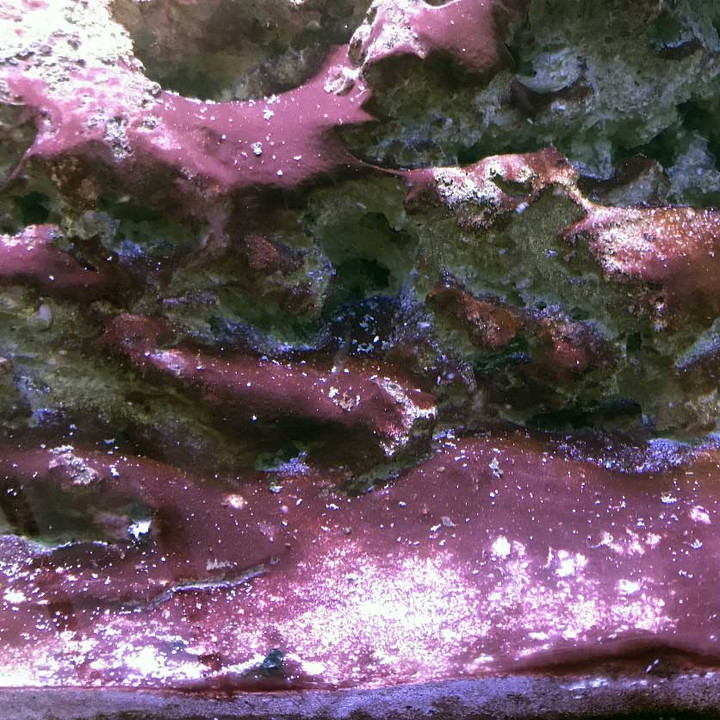Cyanobacteria in a Saltwater Aquarium - Who, What, Where and Why?
Cyanobacteria is a bacteria that does photosynthesis. This isn’t a scientific paper so I’m not going to describe how it does this. All you need to know is that it is ugly and tends to show up during periods where you are not keeping up with the tank like you should be. Still, it can sometimes show up on little patches even in well taken care of tanks. It’s usually a slimy, deep brownish red substance that tries to carpet the rock work and your substrate. The easiest way to take care of it is to use a small diameter hose, like a 3/8” or 1/2”, to siphon it away where it sits. As long as it’s just a little patch then that’s your warning to keep up on your maintenance with the aquarium. If you ignore it for too long, it can spread and I mean spread rapidly. Before you know it you could end up with most of your substrate covered in a slimy, red mess. To my knowledge, there are not very many animals that eat it as I know it can release somewhat toxic substances. If you allow it to reach plague proportions, just be honest with yourself, you’re not putting as much time into the aquarium as it needs or something may be wrong with your filtration. Things like a low quality protein skimmer, inadequate circulation inside the tank, overcrowding and over feeding the fish, neglecting to do regular water changes, are some of the common reasons for this junk to creep up.
Several companies make additives that can help you get rid of the cyanobacteria but unless you address how it got there in the first place, it will usually just come back.
List of Products Designed to Treat Cyanobacteria - https://www.saltwateraquarium.com/specialty/pests-medications/cynobacteria-red-slime/
A hobbyist has the luxury of being patient with the issue, Siphoning out little sections of it as it shows up. I own and run an aquarium maintenance company in Houston and I don’t have that sort of luxury with clientele. When a problem crops up, my clients expects me to fix it yesterday. I completely understand because they are paying me good money to maintain them as nice of an aquarium as possible and to have the answer when something goes wrong. When something does go wrong, I am the expert and I better know how to fix it as quickly as possible.
That’s why I tend to use these chemicals that can get rid of cyanobacteria in order to buy me some time to investigate why it might be showing up. I’ll make that point again because I want to be extremely clear that doing something like buying a chemical to kill the cyanobacteria in your aquarium should not be thought of as the solution by itself. You are just fighting the symptom and not the root cause. That being said, root causes are not always easy to find in reefkeeping. It takes a lot of experience in the hobby to identify the causes of problems and to put a solution into place. If you find yourself plagued by cyanobacteria, you’re going to need to have another aquarist whom you trust, or social media group, to help you thoroughly go over your equipment and husbandry practices. Let other , more experienced reefkeepers help you figure out what the problem might be.
I have actually been pretty successful with just upping the amount and maybe frequency of water changes until I get past the issue, and to be quite honest, sometimes you can just wait the system out as whatever might be fueling the cyanobacteria bloom might possibly run its course. That being said, I would not allow cyanobacteria to completely run rampant in the system I was taking care of. I would also advise you not to freak out too badly or to get too discouraged as it happens to the best of us. I’ve never had a bad experience using many of the red slime removers, something that I’ve probably done over 100 times in my career, but invariably you will find people who have probably erroneously deduced that it messed up their tank further. Just be sure to follow the instructions and heed the advice of other experienced reefkeepers.
Common Related Questions:
How do I get rid of cyanobacteria in my saltwater tank?
What eats cyanobacteria in saltwater tank?
Is cyanobacteria bad for aquarium?
Can cyanobacteria kill corals?
One last bit of advice, something which I think everyone should follow for any sort of aquarium problem, Is to not attempt multiple different fixes for a single issue all at once. It makes more sense to go with one attempted solution and let it go through its full course before attempting something else. If you were doing six different things to fix a problem, not only are you possibly going to exacerbate or even complicate the problem but if the problem subsides, you’re not going to know exactly what fixed it and you will have no knowledge to gain from the experience.
In closing, if you see a little patch of cyanobacteria, just siphon it out and do a little water change. If it comes back quickly and with a vengeance, there is obviously further issues that need to be addressed and you should go over your equipment and husbandry practices. Never forget that this is a hobby and it’s supposed to be fun though so don’t panic. Have fun and keep reefing.
Explore Popular Articles
-
ReefStock Denver is This Weekend!
Feb 27, 2024The time is finally here. Reef Builders ReefStock Show is coming to the Crowne Plaza Hotel in Denve
-
Sicce's New Scuba Heater!
Oct 23, 20235 Year Warranty, High Quality Italian Made, A Heater for the FUTURE! Innovative heater range eq
-
Current USA R24 LOOP LED
Oct 23, 2023Compact lighting with SPS coral growing power. For those who love the Orbit® Marine, the Orbit® R




